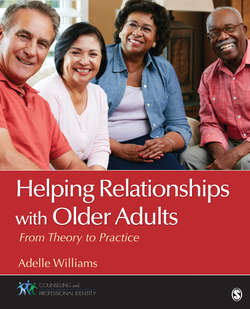Читать книгу Helping Relationships With Older Adults - Adelle M. Williams - Страница 25
На сайте Литреса книга снята с продажи.
Central Nervous System
ОглавлениеThe nervous system is the body’s control center. It controls the body’s movements, senses, thoughts, and memories. It also controls the organs such as the heart and bowels. There are two parts to the nervous system: the central nervous system, which is made up of the brain and spinal cord, and the peripheral nervous system, which is mainly comprised of nerves. The spinal cord is the bundle of nerves that runs from the brain down the center of the back. Nerves extend out from the spinal cord to every part of the body (Dugdale, 2012) and are the pathways that carry signals between the brain and the rest of the body.
As the body ages, the central and peripheral nervous systems go through natural changes. The brain and spinal cord lose nerve cells and weight (atrophy). Nerve cells may begin to pass messages more slowly. Waste products can collect in the brain tissue as nerve cells break down, causing abnormal changes in the brain called plaques and tangles to form. A fatty brown pigment (lipofuscin) can also build up in nerve tissue, which can impair the functioning of seemingly unrelated cellular systems. Lipofuscin has also been associated with dementia and severe memory loss. Breakdown of nerves affect the senses, causing reduced or lost reflexes or sensation, which can lead to problems with movement and safety.
The slowing of thought, memory, and thinking is a normal part of aging. This is caused by changes to the brain’s size, blood vessels, and cognition. As it ages, the brain shrinks in volume, particularly in the frontal cortex. As we age, the blood vessels may stiffen and blood pressure rises, and may result in inadequate oxygen to the heart muscle (ischemia), and a narrowing or blockage of one or more arteries may lead to a stroke and subsequent lesion (area of tissue that has been damaged through injury or disease). As a person’s vasculature ages and blood pressure rises, the possibility of stroke and ischemia increases, and the brain’s white matter develops lesions. Memory decline also occurs, and brain activation becomes more bilateral (use of left and right prefrontal cortex) for memory tasks because older brains tend to show more symmetrical activation (using both the left and right hemispheres). This may be an attempt to compensate and use additional networks or because specific areas are no longer easily accessed. These anatomical changes are linked to a number of functional alterations. In general, neural processing becomes less efficient. For example, memory consolidation often becomes more difficult, and sensory systems of the elderly, notably hearing, balance, vision, smell and taste, become less acute. Light must be brighter, sounds louder, and smells stronger before they are perceived (American Academy of Health and Fitness [AAHF], 2015). Genetics, neurotransmitters, hormones, and experience all play a role in how quickly the brain ages.
